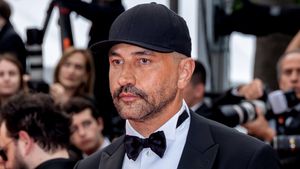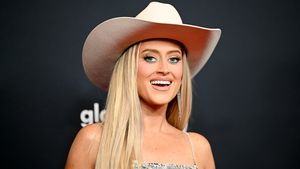Netflix's remake of Spike Lee's film She's Gotta Have It has given the 1986 classic a millennial facelift while keeping its old-school soul. Lee explores his love affair with Brooklyn through a defiantly black lens and celebrates its inhabitants, specifically the free-spirited young artist Nola Darling.
[iframe https://giphy.com/embed/xUOxfdjIX5jETSQWrK allowfullscreen="" class=^{{"giphy-embed"}}^ frameborder="0" height="270" width="480"]
As a self-described "sex-positive polyamorous pansexual," Darling (DeWanda Wise) isn't interested in monogamy—or anyone's perceptions of her. The 20-something juggles three men in her loving bed: the childish yet hilariously charming, Mars Blackman (Anthony Ramos), self-obsessed "biracial Adonis" Greer Childs (Cleo Anthony), and wealthy—and married—businessman Jamie Overstreet (Lyriq Bent). While the trio of men are aware Nola's seeing other people, each wants to plant their flag on Planet Nola to claim her as their own, and each sees Nola differently.
But after being sexually assaulted on the street, Nola begins to struggle with how the men in her life define her.
Nola wrestles with the aftermath of the attack and fights to reclaim her power. She uses her art, an expensive little black dress, therapy, and eventually, a female ex-lover named Opal Gilstrap to work through her trauma.
Nola only runs to Opal when she's decided to go on "a man cleanse," but despite the immature and eye-rolling catalyst, their relationship is loving and familiar. Opal is maternal and mature; an established horticulturist and a mother of a seven-year-old daughter. Their relationship is a breath of fresh air for the viewers, and for Nola.
[iframe https://giphy.com/embed/l2Rnvzw53YEcAxLr2 allowfullscreen="" class=^{{"giphy-embed"}}^ frameborder="0" height="270" width="480"]
Where Nola's men saw her as they wanted her to be, Opal accepted her free spirit, although not always with a smile. When Nola missed a play date with Opal's daughter because she was "caught up painting," Opal promptly cuts her out of her life, unwillingly to settle for the scraps of her time.
"People like me don’t have a choice," she explains to Nola.
It's unclear if Opal's referring to her own sexuality as a lesbian, motherhood, Nola's pansexuality, or Nola's phobia of commitment. It's hard to be sure that Opal is making the comment as it pertains to her own personal life, but don't let it add fuel to the stereotypical fire of promiscuity among pan and bisexuals, even if the very title of the show doesn't exactly help on that front. She's Gotta Have It, seems to imply a kind of deviance, a need for sex that Nola has that perhaps other women don't. But Nola owns her sexual agency so explicitly that the cliche feels empty when pasted on to her. She really just wants the autonomy to exist outside of a box or other people's perceptions.
"I'm not a freak, I'm not a sex addict, and I'm damn sure nobody's property." —Nola Darling
Hesitant to commit to Opal, Nola goes back to her men and the situation rapidly begins to implode. Jealousy and competition run rampant, and despite her explicit set of rules to prevent them from ever running into each other and getting too attached, everything unravels when they all show up at her art show. But instead of focusing on her showcase and an interview with a critic, Nola spends so much time trying to appease the three men that everything goes up in flames.
With the help of her therapist, Nola realizes that she's been compartmentalizing herself for the men's approval. She decides to put everything on the table.
![]()
In the final episode of season one, aptly titled "Nola's Choice," (spoilers ahead), Nola invites all three of the men to Thanksgiving dinner without their knowledge. The air is tense as the trio feel out their competition and size each other up, but Nola systematically rejects any power grab for control over the situation—or her.
After dinner, Nola shares her latest piece of work with the men. A painting titled "The Three-Headed Monster" depicts Greer, Mars, and Jamie in their most vulnerable forms: naked, side-by-side, with their penises drawn proportionally to size, objectified from her point of view.
"It's about being open. Shiny and not shadowy. It's about the truth."
Reluctant at first, the men are shocked, but once they set their egos aside, the foursome launch into an eclectic musical interlude to Prince's "Rasberry Beret." They all fall asleep in Nola's bed (fully clothed) and leave one by one.
Nola wakes up alone. The doorbell rings. Opal's at the door with a bottle of champagne. She buzzes her up.
"Nola Darling," Opal lovingly sighs. Nola laughs. The music swells and the credits roll.
It's important to note that the season ends with a focus on Nola and Opal's relationship. Opal is the only one of her lovers whose really seen all the different parts of Nola from the very beginning and simply accepted them. She never had to hide or compartmentalize with Opal, she just was, and Opal stayed all the way till the end, just loving her. And Nola chooses Opal.
Their relationship might be complicated and messy and far from perfect (just like real life), but we are clamoring for more. It's unclear which direction season 2 will head (if Nola will end up with one of her men or Opal, or if Netflix will even approve more episodes), but we've let the sanctuary of queer love wash over us and are holding #Nopal near and dear to our hearts.
Season 2 premieres May 24th on Netflix.































































































































